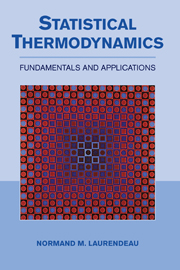Book contents
- Frontmatter
- Contents
- Preface
- 1 Introduction
- PART ONE FUNDAMENTALS OF STATISTICAL THERMODYNAMICS
- 2 Probability and Statistics
- Problem Set I Probability Theory and Statistical Mathematics (Chapter 2)
- 3 The Statistics of Independent Particles
- 4 Thermodynamic Properties in the Dilute Limit
- Problem Set II Statistical Modeling for Thermodynamics (Chapters 3–4)
- PART TWO QUANTUM MECHANICS AND SPECTROSCOPY
- PART THREE STATISTICAL THERMODYNAMICS IN THE DILUTE LIMIT
- PART FOUR STATISTICAL THERMODYNAMICS BEYOND THE DILUTE LIMIT
- PART FIVE NONEQUILIBRIUM STATISTICAL THERMODYNAMICS
- PART SIX THE ENSEMBLE METHOD OF STATISTICAL THERMODYNAMICS
- PART SEVEN APPENDICES
- Index
2 - Probability and Statistics
Published online by Cambridge University Press: 05 June 2012
- Frontmatter
- Contents
- Preface
- 1 Introduction
- PART ONE FUNDAMENTALS OF STATISTICAL THERMODYNAMICS
- 2 Probability and Statistics
- Problem Set I Probability Theory and Statistical Mathematics (Chapter 2)
- 3 The Statistics of Independent Particles
- 4 Thermodynamic Properties in the Dilute Limit
- Problem Set II Statistical Modeling for Thermodynamics (Chapters 3–4)
- PART TWO QUANTUM MECHANICS AND SPECTROSCOPY
- PART THREE STATISTICAL THERMODYNAMICS IN THE DILUTE LIMIT
- PART FOUR STATISTICAL THERMODYNAMICS BEYOND THE DILUTE LIMIT
- PART FIVE NONEQUILIBRIUM STATISTICAL THERMODYNAMICS
- PART SIX THE ENSEMBLE METHOD OF STATISTICAL THERMODYNAMICS
- PART SEVEN APPENDICES
- Index
Summary
In preparation for our study of statistical thermodynamics, we first review some fundamental notions of probability theory, with a special focus on those statistical concepts relevant to atomic and molecular systems. Depending on your background, you might be able to scan quickly Sections 2.1–2.3, but you should pay careful attention to Sections 2.4–2.7.
Probability: Definitions and Basic Concepts
Probability theory is concerned with predicting statistical outcomes. Simple examples of such outcomes include observing a head or tail when tossing a coin, or obtaining the numbers 1, 2, 3, 4, 5, or 6 when throwing a die. For a fairly-weighted coin, we would, of course, expect to see a head for 1∕2 of a large number of tosses; similarly, using a fairly-weighted die, we would expect to get a four for 1∕6 of all throws. We can then say that the probability of observing a head on one toss of a fairly-weighted coin is 1∕2 and that for obtaining a four on one throw of a fairly-weighted die is 1∕6. This heuristic notion of probability can be given mathematical formality via the following definition:
Given Nsmutually exclusive, equally likely points in sample space, with Ne of these points corresponding to the random event A, then the probability P(A) = Ne/Ns.
Here, sample space designates the available Ns occurrences while random event A denotes the subset of sample space given by Ne ≤ Ns.
- Type
- Chapter
- Information
- Statistical ThermodynamicsFundamentals and Applications, pp. 7 - 22Publisher: Cambridge University PressPrint publication year: 2005



